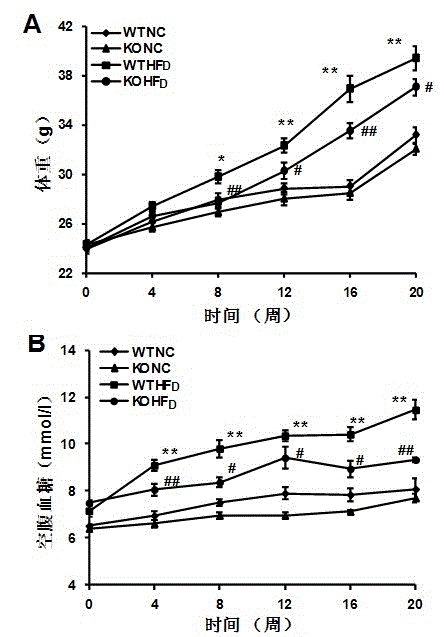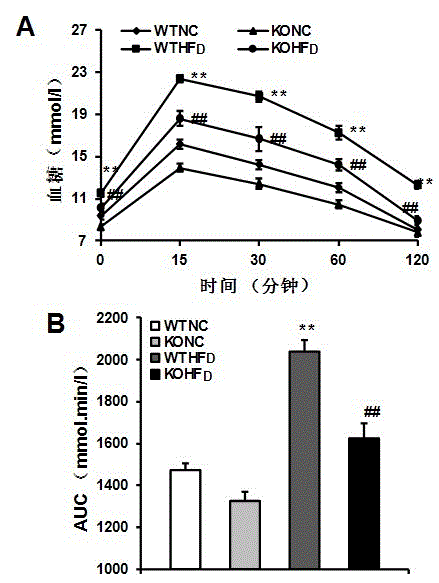Function and application of tumor necrosis factor (TNF) receptor associated factor 1 (TRAF1) in treatment of fatty liver and diabetes mellitus II
A technology for fatty liver and diabetes, which is used in gene therapy, preparations for in vivo experiments, and medical preparations containing active ingredients.
- Summary
- Abstract
- Description
- Claims
- Application Information
AI Technical Summary
Problems solved by technology
Method used
Image
Examples
Embodiment 1
[0031] Example 1 Fatty liver and type 2 diabetes model (diet induced obesity, DIO) obtained in mice
[0032] (1) Grouping of experimental animals: 8-week-old, male, WT mice and TRAF1-KO mice were selected and given two special feeds, D12942 high fat diet (High fat diet, HFD) and D12450B low fat diet (Normal chow , NC) feeding, that is, WT NC group, KO NC group, WT HFD group, KO HFD group, a total of 4 groups.
[0033] (2) Operation process of high-fat feed induction model:
[0034] WT and KO mice were used to establish DIO models, and phenotype correlation analysis was performed to clarify the role of TRAF1 gene on fatty liver and type Ⅱ diabetes. 8-week-old, male, WT mice and TRAF1-KO mice were selected and fed with two special diets, D12942 high-fat diet and D12450B low-fat diet, namely WT NC group, KO NC group, WT HFD group, KO HFD group There are 4 groups in total. The food intake of the mice was recorded in detail every week, and the fasting body weight and fasting blo...
Embodiment 2
[0035] Example 2 Determination of mouse body weight and blood glucose level
[0036] (1) Detection of fasting body weight and food intake of mice
[0037] ①Fasting: Fast the mice to be tested at 8:00 am (without water), and start the experimental operation at 2:00 pm.
[0038] ② Weighing: Weigh at 0 weeks, 4 weeks, 8 weeks, 12 weeks, 16 weeks, and 20 weeks respectively, put a small plastic bucket on the dynamic electronic balance, grab the mouse, and put it into the weighing bucket , measure body weight and record data. Feed amount detection: After the weighing operation is completed, add feed to the mice, and record the amount of feed for the mice on the dynamic electronic balance.
[0039] (2) Fasting blood glucose level detection experiment
[0040] All the mice to be tested were fasted from 8:00 am to 2:00 pm (without water), that is, the experimental operation was started after 6 hours of fasting.
[0041] ① Blood glucose meter preparation: Check the battery of the bl...
Embodiment 3
[0046] Example 3 Intraperitoneal glucose tolerance test (IPGTT)
[0047] On the 18th week of the experiment, the intraperitoneal injection of glucose test (IPGTT) was carried out to evaluate the glucose tolerance of the mice.
[0048] (1) Before measuring blood glucose, measure the fasting body weight of the mice, and calculate the injection volume of glucose based on 10 μL / g.
[0049] (2) First test the fasting blood glucose at 0 minutes before the glucose injection, and inject the glucose solution intraperitoneally quickly after the test is completed.
[0050] (3) Operation method of intraperitoneal injection: ①Fix the mouse; grab the mouse, grasp the tail of the mouse with the little finger and ring finger of the left hand, and grasp the neck of the mouse with the other three fingers, so that the mouse's head is down, and the The abdomen of the mouse is fully exposed. ②Needle positioning and injection: insert the needle from the side of the abdomen, hold the syringe with ...
PUM
| Property | Measurement | Unit |
|---|---|---|
| molecular weight | aaaaa | aaaaa |
Abstract
Description
Claims
Application Information
 Login to View More
Login to View More - R&D
- Intellectual Property
- Life Sciences
- Materials
- Tech Scout
- Unparalleled Data Quality
- Higher Quality Content
- 60% Fewer Hallucinations
Browse by: Latest US Patents, China's latest patents, Technical Efficacy Thesaurus, Application Domain, Technology Topic, Popular Technical Reports.
© 2025 PatSnap. All rights reserved.Legal|Privacy policy|Modern Slavery Act Transparency Statement|Sitemap|About US| Contact US: help@patsnap.com



